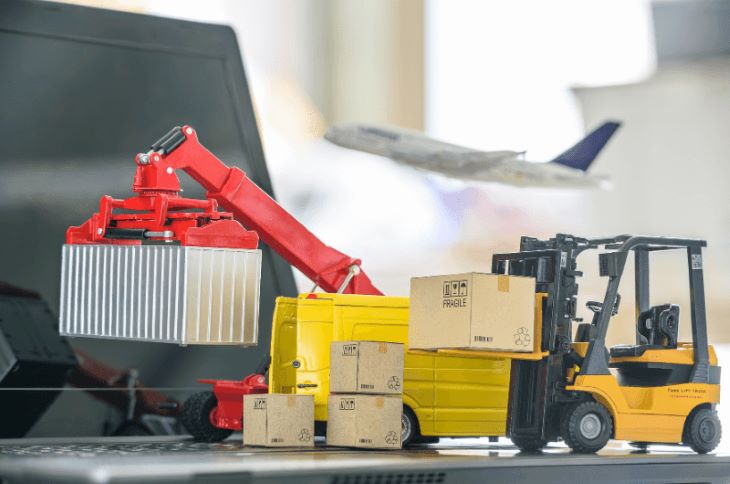5 steps to Logistics Resilience: A Guide to Effective Crisis Management
The threat of unanticipated events and disasters is becoming more and more real in today’s unstable and linked business environment. For organizations of all kinds, especially those in the logistics industry, being able to successfully handle these challenges—whether they come in the form of a natural disaster, a worldwide epidemic, a cyberattack, or an interruption to the supply chain—is more than simply a useful talent.

Source: www.canva.com
We will go deep into the essential steps that organizations may take to get ready for unexpected occurrences and catastrophes. We will also look at real-world examples from some of the top logistics companies in the world, showing their effective coping mechanisms during trying times.
5 Steps to Manage Every Unanticipated Occurrence
The process of locating, analyzing, and reacting to unanticipated occurrences that may interrupt operations and harm an organization’s reputation is known as crisis management. Effective crisis management entails more than just responding to crises; it also involves proactive planning, building resilience, and establishing reliable communication channels to help organizations traverse the choppy waters of uncertainty.
Even while it’s impossible to forecast every crisis, a well-prepared organization can lessen its effects and recover more rapidly. ”Failing to plan is planning to fail” as the old saying goes, and this principle is more relevant than ever in the field of crisis management. Here are five steps that might be useful for you.
Step 1: Risk Assessment
Any effective crisis management strategy starts with a thorough risk assessment. This entails locating possible threats to your company and estimating their potential consequences. Businesses must assess a wide range of risks in the logistics sector, where complexity abounds, including supply chain interruptions, natural disasters, geopolitical conflicts, and cybersecurity attacks.
A thorough grasp of operations, vulnerabilities, and external threats facing the business is necessary for effective risk assessment, which is a comprehensive process. It entails gathering and evaluating data, consulting subject matter experts, and keeping up with new threats. Additionally, it necessitates a proactive mentality where firms continuously review and change their risk assessment procedures to accommodate shifting conditions.
Maersk overcoming the NotPetya ransomware attack
One of the biggest shipping firms in the world, Maersk, was a victim of the infamous NotPetya ransomware assault in 2017. This cyberattack severely damaged Maersk’s IT infrastructure and halted all international operations. However, Maersk carried out a remarkable recovery as a result of their careful risk assessment and crisis management preparations. Even though they could not move their cargo for two days, they got back to normal activity in two weeks. Throughout the crisis, they had open lines of contact with customers and other stakeholders and had reliable backup systems in place, which offered an excellent example of crisis resilience in the logistics sector.

Source: www.canva.com
Step 2: Develop a Detailed Crisis Plan
After identifying potential risks, you should create a thorough crisis management strategy that specifies the precise actions to take in the event of various crises. This strategy should include clear communication channels, roles, duties for important employees, and measures to lower the crisis’s effects.
An organized crisis management strategy is comparable to an orchestrated symphony where each instrument plays a defined part. A thorough incident response structure that specifies how the organization will respond in a crisis should be included. This framework should outline:
- the decision-making process,
- communication tactics,
- resource allocation,
- recovery activities,
- and address a variety of scenarios, from minor disruptions to major emergencies.
FedEx’s heroic response to the Hurricane Katrina disaster
The United States Gulf Coast was ravaged by Hurricane Katrina in 2005, severely disrupting supply chains and logistics systems. As a result, U.S. exports from the Gulf Region decreased to $4.9 billion from $6.1 billion (ITA 2005). Armed with a carefully planned crisis management strategy, logistics company FedEx moved quickly. They changed shipping routes, moved important resources, and gave crucial help for disaster relief. They received praise for their humanitarian actions during a crisis because of their planning, which not only reduced disturbances but also minimized them. Read more about how to optimize the delivery process and shipping routes.

Source: www.canva.com
Step 3: Communication is Crucial
An essential component of crisis management is effective communication. Communication with the public, suppliers, employees, and consumers must always be timely and open. Accurate information can be promptly distributed by establishing communication routes and selecting spokesmen in advance.
Communication acts as a link between a company and its stakeholders during a crisis. It builds confidence, conveys important information, and provides assurance. Effective crisis communication involves actively listening to concerns, obtaining input, and changing techniques in response to changing circumstances.
UPS meeting unprecedented demand with transparency
American company UPS had an exceptional increase in demand for package delivery services at the height of the COVID-19 outbreak. UPS proactively informed customers about service changes, delays, and safety precautions to handle this unprecedented scenario. During a period of extreme uncertainty, their openness and reactivity helped preserve confidence among customers and stakeholders.
In fact, between the years 2020 and 2021, UPS experienced a remarkable growth in annual revenues. Their revenue increased from $84.62 billion to $97.28 billion during this period (Macrotrends, 2023). This represents a growth of approximately 14.96% in revenue year-over-year, showcasing the positive impact of their customer-centric approach during the challenging times of the pandemic.

Source: www.canva.com
Step 4: Test and update your plan frequently
Plans for managing crises shouldn’t be static archives. To make sure that the plan continues to be useful and effective, regular testing and changes are essential. The use of scenario simulations, mock drills, and post-crisis reviews can assist in finding flaws and potential improvement areas.
A building’s fire drills are analogous to the crisis management plan’s testing. It guarantees that everyone is aware of their responsibilities, knows where to acquire necessary supplies, and is prepared to act quickly in the event of an emergency. These tests can also reveal planning faults, unforeseen obstacles, and bottlenecks that might otherwise go unnoticed until a true crisis arises.
DHL’s proactive crisis management strategy
DHL, a leader in global logistics, often puts its crisis management plans to the test using a variety of scenarios, such as severe weather catastrophes, geopolitical upheavals, and public health crises. This proactive approach has helped DHL retain the resilience of its supply chain operations and respond quickly to new issues, further solidifying its position as an industry leader in crisis management. A great example is the COVID-19 pandemic. During the outbreak, DHL’s proactive attitude to crisis management was extremely helpful. For pandemic eventualities, they had created measures that included procuring additional warehouse space and alternate shipping routes. This readiness enabled DHL to swiftly adapt and maintain supply chain operations while assisting other organizations.

Source: www.canva.com
Step 5: Develop a resilient supply chain
Supply chains at logistics organizations must be made resilient to be ready for unforeseen occurrences and catastrophes. This involves diversifying the sources of supplies thanks to friend-shoring (redirecting supply chains to countries seen as politically and economically secure or relatively safe), setting up redundant systems, and storing essential resources in case of disruptions.
Developing an adaptive and flexible ecosystem that can thrive in the face of difficulty is key to achieving supply chain resilience. It entails creating strategic alliances with suppliers, creating backup plans, and utilizing technology to track and manage supply chain risks in real-time.
Amazon’s supply chain resilience
Amazon, which is well known for having a strong supply chain, has made significant efforts to increase resilience. Amazon showed impressive agility during the COVID-19 pandemic’s early phases when supply chain interruptions were common. They quickly found substitute suppliers, improved logistics, and stuck to their promise to satisfy client demand. Their unshakable commitment to resilience made a big contribution to their capacity to flourish in trying circumstances.
With revenues of $108.5 billion in the first quarter of 2021, up 44 percent from the same period the prior year, Amazon reported remarkable financial achievements. The shift toward online purchasing brought on by the pandemic and the expansion of Amazon’s successful business divisions led to the company making a significant gain in profit, with $8.1 billion, or a 220 % increase over the same time the year prior.
With such a rapid increase in sales volume, it is also necessary to maximize the utilization of cargo space in all types of transport. For this purpose, there is load planning software that helps companies with efficient cargo loading.

Source: www.canva.com
Not everyone is prepared for everything
Crisis management does not always go well. In the field of business, there have been situations where organizations have had to deal with significant crises, and their answers have come up short, having negative repercussions. Let’s look at three noteworthy instances where businesses struggled to handle crises successfully.
Dieselgate
When it was discovered that Volkswagen (VW), one of the top automakers in the world, had purposefully inserted software in its diesel vehicles to cheat on emissions tests, a serious crisis erupted in 2015. Aside from forcing the recall of millions of vehicles, this incident severely damaged VW’s reputation.
At first, VW’s crisis management strategy lacked accountability and openness. The corporation failed to effectively interact with regulators, clients, and the general public. They initially understated the severity of the problem. As a result, VW was hit with hefty fines and a decline in stock price. Since the finding, VW has lost nearly 30% of its stock value. Another negative impact was a decrease in customer confidence.
To win back the public’s trust and get past the crisis, the business then fired its CEO, started a large recall, and decided to invest in electric vehicle technology. In 2022, VW delivered 4.5 million cars of which 330,000 were electric cars, which is almost a 24% increase compared to the year prior. Even though VW is trying, the price of its shares has remained within a similar price range since the Dieselgate announcement.

Source: www.canva.com
A horse is a new cow
Tesco, a big British retailer, experienced a serious disaster in 2013 dubbed the ”horse meat scandal.” This problem resulted from the inappropriate handling and labeling of beef products in the supply chain. Concerns regarding food safety and customer trust were raised when it was discovered that Tesco’s beef products, including frozen burgers and ready-made dinners, contained horse meat rather than only pure beef as stated on the label.
Tesco’s crisis management approach received harsh criticism for being deficient in supply chain management and quality assurance. The incident serves as a reminder of how crucial it is to manage the supply chain efficiently, ensure that labels are accurate, and preserve the quality and safety of food products from manufacturing to sale. Moreover, it demonstrates how such an incident can negatively affect a company’s reputation. How did it all end? It was discovered that the source of “beef” meat from Romania is unreliable, and therefore, Tesco decided to start using meat from local sources.

Source: www.canva.com
Bridge Fall
In August 2007, a sad incident occurred when the I-35W Mississippi River bridge collapsed in the middle of the evening rush hour in Minneapolis, Minnesota. Multiple people died as a result of this tragic occurrence, many more were hurt, and vital transportation infrastructure was severely damaged. Although structural flaws and outdated infrastructure were identified as the main causes of the bridge collapse, it is important to remember that incorrect loading and overweight cars also contributed to the incident. The bridge was carrying materials and equipment that were too heavy at the time of the collapse, adding to the structural stress on the deteriorating bridge.
Following the early initiation of rescue and recovery operations in response to this catastrophe, thorough studies into the disaster’s underlying causes were conducted. Plans for the bridge’s reconstruction have also been started. This terrible event served as a sobering reminder of the critical need for thorough infrastructure upkeep and adherence to strict safety regulations within transportation networks, underlining the severe repercussions when such procedures are disregarded.
Since then, America has started to invest more in inspecting and repairing bridges. Unfortunately, still around 7 % of the bridges in America are considered unsuitable for use. Despite this finding, 178 million vehicles are crossing these bridges every day (Infrastructure report card 2021).

Source: www.canva.com




